Urban Geothermal Resource Potential Mapping Using Data-Driven Models—A Case Study of Zhuhai City
Abstract
:1. Introduction
2. Materials and Methods
2.1. Study Area
2.2. Data Source and Methodology
2.3. Geological Indicators
2.3.1. Geological Structure
2.3.2. Analysis of Digital Elevation Models
2.3.3. Lithology
2.4. Land Surface Temperature
2.5. Urban Region Correction
2.6. Analysis Models
2.6.1. Support Vector Machine (SVM)
2.6.2. Multilayer Perceptron (MLP)
3. Results
3.1. Geological Characteristics
3.2. LST and Threshold Segmentation
3.3. Geothermal Potential Anomaly Mapping
4. Discussion
5. Conclusions
- (1)
- Applying TIR technology to identify the spatial distribution of the LST is both feasible and effective, and, through UTALFE, we can reclassify the LST results to eliminate the effects of urban heat islands for the future detection of geothermal resources in urban areas.
- (2)
- SVM and MLP data-driven models have been used to predict the geothermal probability. Through model interpretation, the moderate-susceptibility class is found to dominate, at 26.90% (SVM) and 46.27% (MLP), and the results shift to 24.16% (SVM) and 28.67% (MLP) after the correction of the original LST by identifying urban areas of thermal anomalies via the UTALFE method.
- (3)
- Although the results regarding the five susceptibility levels for the above models are different, the highest results are consistently located in the middle of the city, expanding towards the northeast. In our subsequent study, we will focus on these areas in our fieldwork.
- (4)
- We found that the results calculated based on the reclassified LST had higher precision than the original LST values, and the AUC value of SVM was the highest, at 0.815, showing optimal applicability for the mapping of potential geothermal resources. In the future, the method applied in this study may be considered to carry out prospective work in the exploration of more southeastern coastal cities in China.
Author Contributions
Funding
Institutional Review Board Statement
Informed Consent Statement
Data Availability Statement
Acknowledgments
Conflicts of Interest
References
- Gao, Y.F.; Li, B.Z.; Wang, Z.H.; Yang, Y.L. Thermal environment analysis of mountainous towns based on GIS. J. Cent. S. Univ. 2009, S1, 230–234. [Google Scholar]
- Jurišić, M.; Frangeš, S.; Plaščak, I.; Šiljeg, A. Methodology of Development of Purpose Maps in GIS Environment–Resource Management. Geod. List 2013, 1, 1–12. [Google Scholar]
- Gemitzi, A.; Dalampakis, P.; Falalakis, G. Detecting geothermal anomalies using Landsat 8 thermal infrared remotely sensed data. Int. J. Appl. Earth Obs. Geoinf. 2021, 96, 102283. [Google Scholar] [CrossRef]
- Liu, J.Y.; Chao, J.Q.; Zhao, Z.F.; Xu, S.; Lai, Z.; Yang, H.; Chen, Q.; Tu, Y. Identification of geothermal potential based on land surface temperature derived from remotely sensed data. Environ. Sci. Pollut. Res. 2023, 47, 104726–104741. [Google Scholar] [CrossRef] [PubMed]
- Hamamoto, H.; Yamno, M.; Goto, S.; Taniguchi, M. Estimation of the past ground surface temperature history from subsurface temperature distribution: Application to the Bangkok area. Geophys. Explor. 2009, 62, 575–584. [Google Scholar]
- Liu, W.Y. Development of Geothermal Resources in Hongtong Realize Energy Saving and Emission Reduction. Shanxi Coking Coal Sci. Technol. 2011, 35, 54–56. [Google Scholar]
- Rae, A.J.; Rosenberg, M.D.; Bignall, G.; Kilgour, G.N.; Milicich, S.D. Geological results of production well drilling in the western steamfield, Ohaaki geothermal system: 2005–2007. In Proceedings of the 29th New Zealand Geothermal Workshop; University of Auckland: Auckland, New Zealand, 2007. [Google Scholar]
- Xiao, D.; Wei, H.; Shi, S.M.; Zhu, H.; Gan, S.; Wu, X.; Feng, W. Research of Geothermal Resources on Hot Dry Rock in North Songliao Basin of China. Int. J. Energy 2023, 2, 1–4. [Google Scholar] [CrossRef]
- Vaccaro, M. Multidisciplinary Approach for the Sustainable Utilization of Medium-Low Temperature Geothermal Resources. Ph.D. Thesis, University of Pisa, Pisa, Italy, 2013. [Google Scholar]
- Coolbaugh, M.F.; Raines, G.L.; Zehner, R.E. Assessment of exploration bias in data-driven predictive models and the estimation of undiscovered resources. Nat. Resour. Res. 2007, 16, 199–207. [Google Scholar] [CrossRef]
- Coolbaugh, M.F.; Shevenell, L.A. A method for estimating undiscovered geothermal resources in nevada and the great basin. Geotherm. Resour. Counc. Trans. 2004, 28, 13–18. [Google Scholar]
- Mutua, J.; Mibei, G. Remote sensing application in geothermal exploration: Case study of Barrier volcanic complex Kenya. Trans.-Geotherm. Resour. Counc. 2011, 35, 943–947. [Google Scholar]
- Xiong, Y.Z.; Chen, F.; Huang, S.P. Application of remote sensing technique to the identification of geothermal anomaly in Tengchong area, southwest China. J. Chengdu Univ. Technol. (Sci. Technol. Ed.) 2016, 43, 109–118. [Google Scholar]
- Bian, Y.; Yang, Y.P.; Li, M.; He, X.; Tang, H.; Sun, A.; Ju, X. Application of thermal infrared remote sensing techniques in geothermal resources surveying. China Min. Mag. 2021, 5, 153–157. [Google Scholar]
- Papale, R.; Parri, R.; Xodo, L.; Pesenti, D.; Tori, G.; Brogi, R.; Giannecchini, L. A Remote-Diagnostics and Predictive Maintenance Solution for Geothermal Power Plants. In Proceedings of the 8th African Rift Geothermal Conference, Nairobi, Kenya, 2–8 November 2020. [Google Scholar]
- Gao, W.; Zhao, J. Prediction of geothermal temperature field by multi-attribute neural network. Geotherm. Energy 2024, 12, 22. [Google Scholar] [CrossRef]
- Tang, Q.Y.; Zhang, Y. Assessment algorithm of the regional geothermal based on neural network. Renew. Energy Resour. 2013, 31, 90–93. [Google Scholar]
- Tura, N.; Ojanen, V.; Paloviita, T.; Piiparinen, S. Multiple Helix Approach in Advancing Sustainable Urban Energy Ecosystems. In Proceedings of the 2018 IEEE International Conference on Industrial Engineering and Engineering Management (IEEM), Bangkok, Thailand, 16–19 December 2018; IEEE: Piscataway, NJ, USA, 2018. [Google Scholar]
- Theodoridou, I.; Karteris, M.; Mallinis, G.; Papadopoulos, A.M.; Hegger, M. Assessment of retrofitting measures and solar systems’ potential in urban areas using Geographical Information Systems: Application to a Mediterranean city. Renew. Sustain. Energy Rev. 2012, 16, 6239–6261. [Google Scholar] [CrossRef]
- Cumo, F.; Garcia, D.A.; Calcagnini, L.; Rosa, F.; Sferra, A.S. Urban policies and sustainable energy management. Sustain. Cities Soc. 2012, 4, 29–34. [Google Scholar] [CrossRef]
- Zhang, N.; Qin, Q.; He, L.; Jiang, H. Remote sensing and GIS based geothermal exploration in southwest Tengchong, China. In Proceedings of the IEEE International Geoscience and Remote Sensing Symposium, Munich, Germany, 22–27 July 2012; IEEE: Piscataway, NJ, USA, 2012; pp. 5364–5367. [Google Scholar]
- Moghaddam, M.; Pourbaige, M.; Tabar, H.K.; Farhadi, N.; Hosseini, S.M.A. Composition and Antifungal Activity of Peppermint (Mentha piperita) Essential Oil from Iran. J. Essent. Oil Bear. Plants 2013, 16, 506–512. [Google Scholar] [CrossRef]
- Sadeghi, B.; Gholamhoseinpoor, F. A study on the stability and green synthesis of silver nanoparticles using Ziziphora tenuior (Zt) extract at room temperature. Spectrochim. Acta Part A Mol. Biomol. Spectrosc. 2015, 134, 310. [Google Scholar] [CrossRef]
- Zheng, W.B.; Deng, H.W. High-resolution sequence stratigraphic division and distribution of tidal deposits in the Zhuhai Formation, Huizhou Sag, Pearl River Mouth Basin, South China Sea. Geol. Mag. 2012, 149, 722–728. [Google Scholar] [CrossRef]
- Luo, C.W.; Huang, L.C.; Heng, J.W.; Huang, H.W.; Cai, S. The influence of temperature on geothermal power plant performance based on geology in Huangshadong geothermal field, China. Therm. Sci. 2023, 27, 4361–4373. [Google Scholar] [CrossRef]
- Lu, G.P.; Liu, R.F. Aqueous Chemistry of Typical Geothermal Springs with Deep Faults in Xinyi and Fengshun in Guangdong Province, China. J. Earth Sci. 2015, 26, 60–72. [Google Scholar] [CrossRef]
- Xiong, X.B.; Qin, Y.Z.; Sheng, X.J.; Liu, Y.P.; Xu, Q. Research on Engineering Geology Teaching—Take Hong Kong-Zhuhai-Macau Bridge and Tunnel Engineering as a Case. Educ. Res. Front. 2014, 4, 137–142. [Google Scholar]
- Xie, L.H.; Lin, C.S.; Dong, W.; Qin, C.G.; Zhang, Z.T.; Liang, X. High-resolution sequence stratigraphy of Zhujiang Formation and Zhuhai Formation in Panyu low uplift of the Zhujiang River mouth basin. Geol. China 2009, 36, 366–377. [Google Scholar]
- Chen, C.; Zheng, Z.; Zeng, L.F.; Xiao, F.; Tian, L.P.; Huang, K.Y. A combined geophysical and lithological study on eruptive history and Quaternary lacustrine stratigraphy of a maar in Leizhou Peninsula, China. J. Palaeogeogr. 2021, 10, 1–14. [Google Scholar] [CrossRef]
- Xie, H.; Yang, Z.; Deng, J. Assessment of Geothermal Resource Potential in the Guangdong-Hong Kong-Macao Greater Bay Area. Adv. Eng. Sci. 2019, 51, 5–12. [Google Scholar]
- Yan, X.; Lin, W.; Gan, H.; Yue, G.; Wang, G. Hydrogeochemical Characteristics of Huangshadong Geothermal Filed in Guangdong. IOP Conf. Ser. Earth Environ. Sci. 2019, 237, 032128. [Google Scholar] [CrossRef]
- Luo, W.; Fang, Y.; Gong, C.; Li, M.H.; Hu, X.Y. Study on geological characteristics of Sankeng geothermal field in Qingyuan, Guangdong Province and investigation practice. Yangtze River 2015, 46, 22–25. [Google Scholar]
- Chen, W.Y.; Jim, C.Y. Cost–benefit analysis of the leisure value of urban greening in the new Chinese city of Zhuhai. Cities 2008, 25, 298–309. [Google Scholar] [CrossRef]
- Chen, Z.; Davey, G. Subjective Quality of Life in Zhuhai City, South China: A Public Survey Using the International Wellbeing Index. Soc. Indic. Res. 2009, 91, 243–258. [Google Scholar] [CrossRef]
- Liu, B.J. Characteristics of continental delta deposits in Zhuhai Formation of Baiyun Depression in Pearl River Mouth Basin. Acta Pet. Sin. 2007, 28, 49–51. [Google Scholar]
- Bignall, G.; Milicich, S.D.; Ramirez, L.E.; Rosenberg, M.; Kilgour, G.; Rae, A. Geology of the Wairakei-Tauhara Geothermal System, New Zealand. In Proceedings of the Proceedings World Geothermal Congress 2010, Bali, Indonesia, 25–29 April 2010. [Google Scholar]
- Waibel, A.F. An overview of the geology and secondary mineralogy of the high temperature geothermal system in Dixie Valley, Nevada. Res. Gate 1987, 11, 479–486. [Google Scholar]
- Li, X.Y.; Cai, H.T.; Ren, Q.L. A Tentative Discussion on the Geothermo–Geological Characteristics and Development of Geothermal Resources in Cangzhou City. Acta Geosci. Sin. 2000, 21, 171–176. [Google Scholar]
- Bai, Y.C.; Li, Y.L.; Qi, F.L.; Zhang, F.L. Analysis of metallogenic conditions of geothermal resources in heiyu lake of daqing. Adv. Mater. Res. 2012, 550–553, 2472–2477. [Google Scholar] [CrossRef]
- Wood, C.P. Geology of the rotorua geothermal system. Geothermics 1992, 21, 25–41. [Google Scholar] [CrossRef]
- Bertini, G.; Casini, M.; Gianelli, G.; Pandeli, E. Geological structure of a long_iving geothermal system, Larderello, Italy. Terra Nova 2006, 18, 163–169. [Google Scholar] [CrossRef]
- Coolbaugh, M.F.; Kratt, C.; Fallacaro, A.; Calvin, W.M.; Taranik, J.V. Detection of geothermal anomalies using advanced spaceborne thermal emission and reflection radiometer (aster) thermal infrared images at Bradys hot springs, Nevada, USA. Remote Sens. Environ. 2007, 106, 350–359. [Google Scholar] [CrossRef]
- Kuria, Z.N.; Woldai, T.; Meer, F.D.V.D.; Barongo, J.O. Active fault segments as potential earthquake sources: Inferences from integrated geophysical mapping of the Magadi fault system, southern Kenya rift. J. Afr. Earth Sci. 2010, 57, 345–359. [Google Scholar] [CrossRef]
- Manzella, A. Geophysical Methods in Geothermal Exploration; Italian National Research Council International Institute for Geothermal Research: Pisa, Italy, 2005. [Google Scholar]
- D’Antonio, M. Lithology of the basement underlying the Campi Flegrei caldera: Volcanological and petrological constraints. J. Volcanol. Geotherm. Res. 2011, 200, 91–98. [Google Scholar] [CrossRef]
- Chorowicz, J.; Lavreau, J.; Tamain, G.; Theunissen, K.; Bardinet, C.; Girault, F.; Klerkx, J.; Le Page, A.; Nanyaro, J.; Nimpagaritse, G.; et al. The evaluation of satellite imagery and field Spectro-radiometer data for the study of the lithology and the ancient and reactivation tectonics in the vicinity of the east African rift. ISPRS J. Photogramm. Remote Sens. 1990, 45, 355–381. [Google Scholar] [CrossRef]
- Mawardi, S.; Sukiyah, E.; Haryanto, I. Morphotectonic characteristics of Cisadane Watersshed based on satellite images analysis. J. Geol. Dan Sumberd. Miner. 2019, 20, 175. [Google Scholar] [CrossRef]
- Chakrabarti, A.; Cormode, G.; Mcgregor, A. A near-optimal algorithm for estimating the entropy of a stream. ACM Trans. Algorithms 2010, 6, 145–148. [Google Scholar] [CrossRef]
- Jimenez-Munoz, J.C.; Sobrino, J.A.; Skokovic, D.; Mattar, C.; Cristobal, J. Land surface temperature retrieval methods from landsat-8 thermal infrared sensor data. IEEE Geosci. Remote Sens. Lett. 2014, 11, 1840–1843. [Google Scholar] [CrossRef]
- Wang, S.; He, L.; Hu, W. A temperature and emissivity separation algorithm for landsat-8 thermal infrared sensor data. Remote Sens. 2015, 12, 9904–9927. [Google Scholar] [CrossRef]
- Nishar, A.; Richards, S.; Breen, D.; Robertson, J.; Breen, B. Thermal infrared imaging of geothermal environments and by an unmanned aerial vehicle (UAV): A case study of the Wairakei–Tauhara geothermal field, Taupo, New Zealand. Renew. Energy 2016, 86, 1256–1264. [Google Scholar] [CrossRef]
- Sobrino, J.A.; Jiménez-Muñoz, J.C. Minimum configuration of thermal infrared bands for land surface temperature and emissivity estimation in the context of potential future missions. Remote Sens. Environ. Interdiscip. J. 2014, 148, 158–167. [Google Scholar] [CrossRef]
- Sobrino, J.A.; Jiménez-Muñoz, J.C.; Paolini, L. Land surface temperature retrieval from LANDSAT TM 5. Remote Sens. Environ. Interdiscip. J. 2014, 90, 434–440. [Google Scholar] [CrossRef]
- Chen, L.; Bai, Z.P.; Su, D.; You, Y.; Li, H.; Liu, Q. Application of land use regression to simulate ambient air PM10 and NO2 concentration in Tianjin City. China Environ. Ence 2009, 29, 685–691. [Google Scholar]
- Jiménez-Muñoz, J.C.; Sobrino, J.A.; Gillespie, A.R. Surface emissivity retrieval from airborne hyperspectral scanner data: Insights on atmospheric correction and noise removal. IEEE Geosci. Remote Sens. Lett. 2012, 9, 180–184. [Google Scholar] [CrossRef]
- Arola, T.; Korkka-Niemi, K. The effect of urban heat islands on geothermal potential: Examples from quaternary aquifers in finland. Hydrogeol. J. 2014, 22, 1953–1967. [Google Scholar] [CrossRef]
- Changnon, S.A.J.; Huff, F.A. The urban-related nocturnal rainfall anomaly at St. Louis. J. Clim. Appl. Meteorol. 2010, 25, 1985–1995. [Google Scholar] [CrossRef]
- Allen, A.; Milenic, D.; Sikora, P. Shallow gravel aquifers and the urban ‘heat island’ effect: A source of low enthalpy geothermal energy. Geothermics 2003, 32, 569–578. [Google Scholar] [CrossRef]
- Achour, Y.; Pourghasemi, H.R. How do machine learning techniques help in increasing accuracy of landslide susceptibility maps? Geosci. Front. 2019, 11, 871–883. [Google Scholar] [CrossRef]
- Mahdadi, F.; Boumezbeur, A.; Hadji, R.; Kanungo, D.P.; Zahri, F. GIS-based landslide susceptibility assessment using statistical models: A case study from Souk Ahras province, NE Algeria. Arab. J. Geosci. 2018, 11, 476. [Google Scholar] [CrossRef]
- Daya, S.B.; Cheng, Q.; Agterberg, F. Handbook of Mathematical Geosciences; Springer International Publishing: Cham, Switzerland, 2018. [Google Scholar]
- Tien Bui, D.; Tuan, T.A.; Klempe, H.; Pradhan, B.; Revhaug, I. Spatial prediction models for shallow landslide hazards: A comparative assessment of the efficacy of support vector machines, artificial neural networks, kernel logistic regression, and logistic model tree. Landslides 2016, 13, 361–378. [Google Scholar] [CrossRef]
- Hong, H.; Liu, J.; Zhu, A.-X.; Shahabi, H.; Pham, B.T.; Chen, W.; Pradhan, B.; Bui, D.T. A novel hybrid integration model using support vector machines and random subspace for weather–triggered landslide susceptibility assessment in the Wuning area (China). Environ. Earth Sci. 2017, 76, 652. [Google Scholar] [CrossRef]
- Shevade, S.K.; Keerthi, S.S.; Bhattacharyya, C.; Murthy, K.R.K. Improvements to the SMO algorithm for SVM regression. IEEE Trans. Neural Netw. 2000, 11, 1188–1193. [Google Scholar] [CrossRef] [PubMed]
- Tarabalka, Y.; Fauvel, M.; Chanussot, J.; Benediktsson, J.A. SVM and MRF–based method for accurate classification of hyperspectral images. IEEE Geosci. Remote Sens. Lett. 2010, 7, 736–740. [Google Scholar] [CrossRef]
- Zhang, X.; Lu, X.; Shi, Q.; Xu, X.Q.; Leung, H.C.E.; Harris, L.N.; Iglehart, J.D.; Miron, A.; Liu, J.S.; Wong, W.H. Recursive svm feature selection and sample classification for mass–spectrometry and microarray data. BMC Bioinform. 2006, 7, 197. [Google Scholar] [CrossRef]
- Lee, Y.J.; Mangasarian, O.L. SSVM: A smooth support vector machine for classification. Comput. Optim. Appl. 2001, 20, 5–22. [Google Scholar] [CrossRef]
- Keerthi, S.S.; Gilbert, E.G. Convergence of a generalized SMO algorithm for SVM classifier design. Mach. Learn. 2002, 46, 351–360. [Google Scholar] [CrossRef]
- Fine, S.; Scheinberg, K. Efficient SVM training using low-rank kernel representations. J. Mach. Learn. Res. 2001, 2, 243–264. [Google Scholar]
- Wang, J.; Yang, Y.; Mao, J.H.; Huang, Z.; Huang, C.; Xu, W. CNN-RNN: A Unified Framework for Multi-label Image Classification. In Proceedings of the IEEE Conference on Computer Vision and Pattern Recognition, Las Vegas, NV, USA, 27–30 June 2016; pp. 2285–2294. [Google Scholar]
- Amid, S.; Gundoshmian, T.M. Prediction of output energies for broiler production using linear regression, ANN (MLP, RBF), and ANFIS models. Environ. Prog. Sustain. Energy 2017, 36, 577–585. [Google Scholar] [CrossRef]
- Ouma, Y.O.; Moalafhi, D.B.; Anderson, G.; Nkwae, B.; Odirile, P.; Parida, B.P.; Qi, J. Dam water level prediction using vector AutoRegression, random forest regression and MLP–ANN models based on land–use and climate factors. Sustainability 2022, 14, 14934. [Google Scholar] [CrossRef]
- Yilmaz, I.; Kaynar, O. Multiple regression, ANN (RBF, MLP) and ANFIS models for prediction of swell potential of clayey soils. Expert Syst. Appl. 2011, 38, 5958–5966. [Google Scholar] [CrossRef]
- Jeong, M.S.; Jang, H.W.; Kim, J.S.; Lee, J.H. Roc evaluation for MLP ANN drought forecasting model. J. Korea Water Resour. Assoc. 2016, 49, 877–885. [Google Scholar]
- Qayyum, F.; Jamil, H.; Iqbal, N.; Kim, D.H.; Afzal, M.T. Toward potential hybrid features evaluation using MLP–ANN binary classification model to tackle meaningful citations. Scientometrics 2022, 127, 6471–6499. [Google Scholar] [CrossRef]
- Li, X.; Huang, C.; Chen, W.; Li, Y.; Han, J.; Wang, X.; Bai, X.; Yin, Z.; Li, X.; Hou, P.; et al. Gis model for geothermal advantageous target selection. Sci. Rep. 2023, 13, 6024. [Google Scholar] [CrossRef]
- Noorollahi, Y.; Itoi, R.; Fujii, H.; Tanaka, T. Gis model for geothermal resource exploration in Akita and Iwate prefectures, northern japan. Comput. Geosci. 2007, 33, 1008–1021. [Google Scholar] [CrossRef]
- Zhao, X.G.; Wan, G. Current situation and prospect of Chinas geothermal resources. Renew. Sustain. Energy Rev. 2014, 32, 651–661. [Google Scholar] [CrossRef]
- Tureyen, O.I.; Sarak, H.; Altun, G.; Satman, A. A modeling analysis of unitized production: Understanding sustainable management of single-phase geothermal resources with multiple lease owners. Geothermics 2015, 55, 159–170. [Google Scholar] [CrossRef]
- Haak, V.; Ritter, O.; Ritter, P. Mapping the geothermal anomaly on the island of milos by magnetotellurics. Geothermics 1989, 18, 533–546. [Google Scholar] [CrossRef]
- Chunhua, L.; Lizhi, Y.; Zhongye, L. Assessment and utilization of geothermal resources in Linqing City, Shandong province. Urban Geol. 2009, 212, 194–208. [Google Scholar]
- Romaguera, M.; Vaughan, R.; Ettema, J.; Izquierdo-Verdiguier, E.; Hecker, C.; van der Meer, F. Detecting geothermal anomalies and evaluating LST geothermal component by combining thermal remote sensing time series and land surface model data. Remote Sens. Environ. Interdiscip. J. 2018, 204, 534–552. [Google Scholar] [CrossRef]
- Peng, F.; Xiong, Y.Z.; Cheng, Y.X.; Fan, Q.C.; Huang, S.P. Towards application of remote sensing technology in geothermal prospecting in Xilingol in eastern inner Mongolia, NE China. Adv. Mater. Res. 2013, 610–613, 3628–3631. [Google Scholar] [CrossRef]
- Zouzias, D.; Miliaresis, G.C.; Seymour, K.S. Probable regional geothermal field reconnaissance in the Aegean region from modern multi-temporal night LST imagery. Environ. Earth Sci. 2011, 62, 717–723. [Google Scholar] [CrossRef]


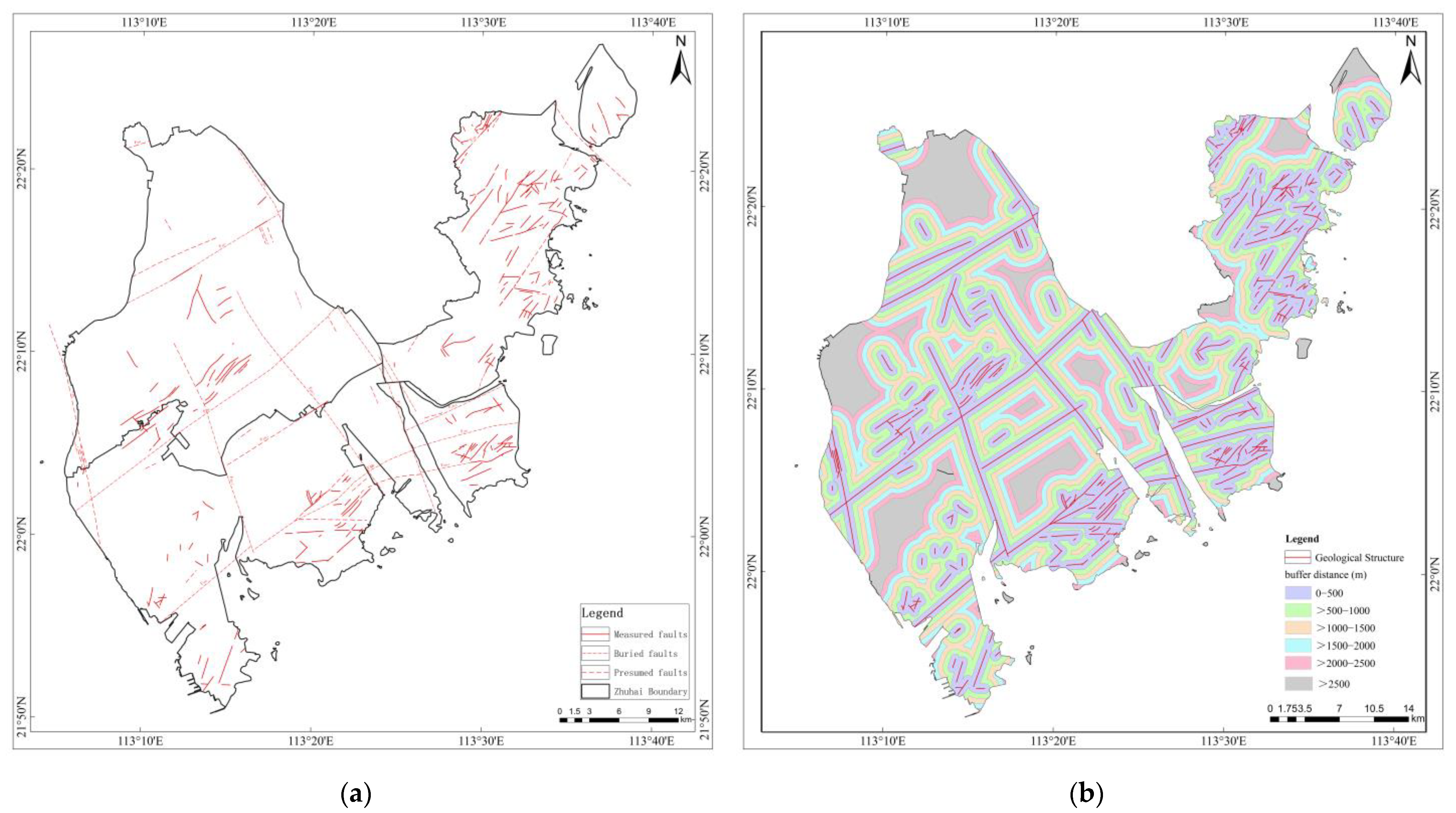
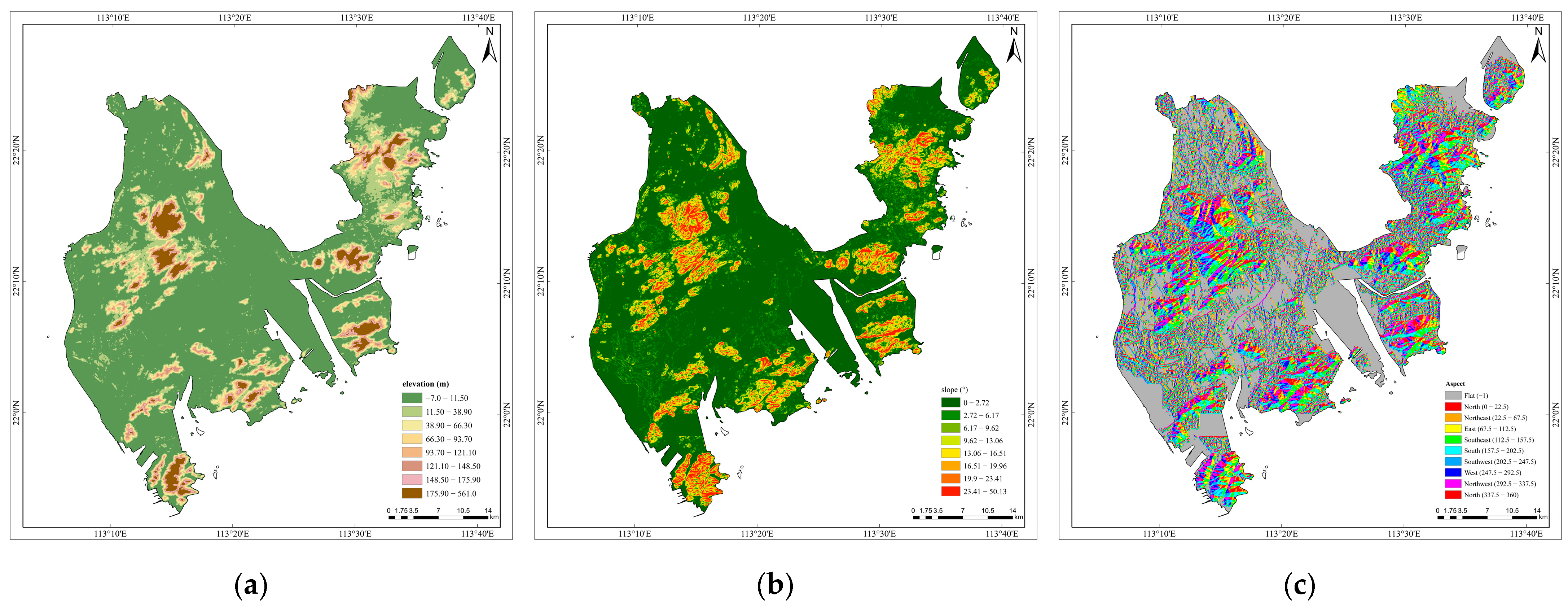
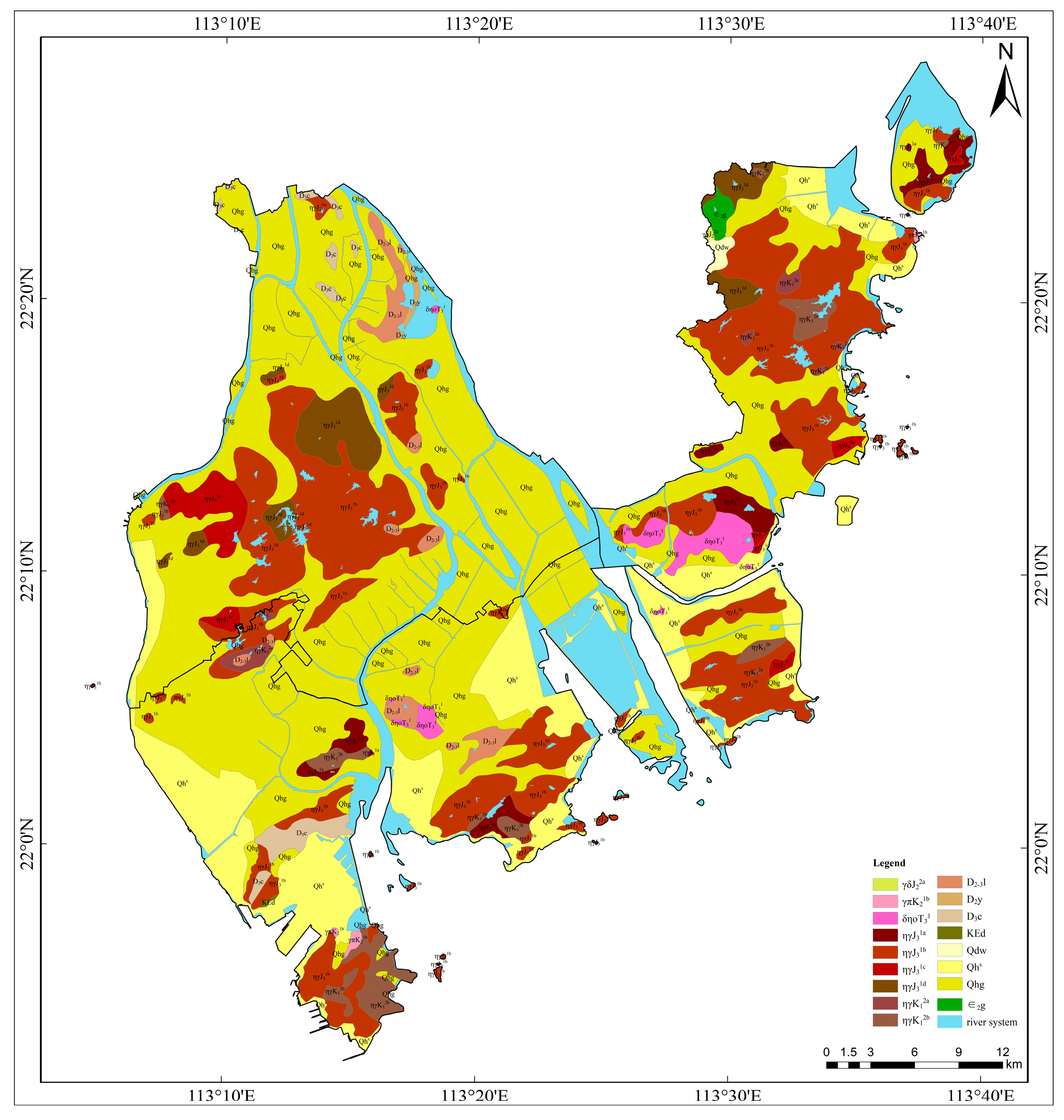


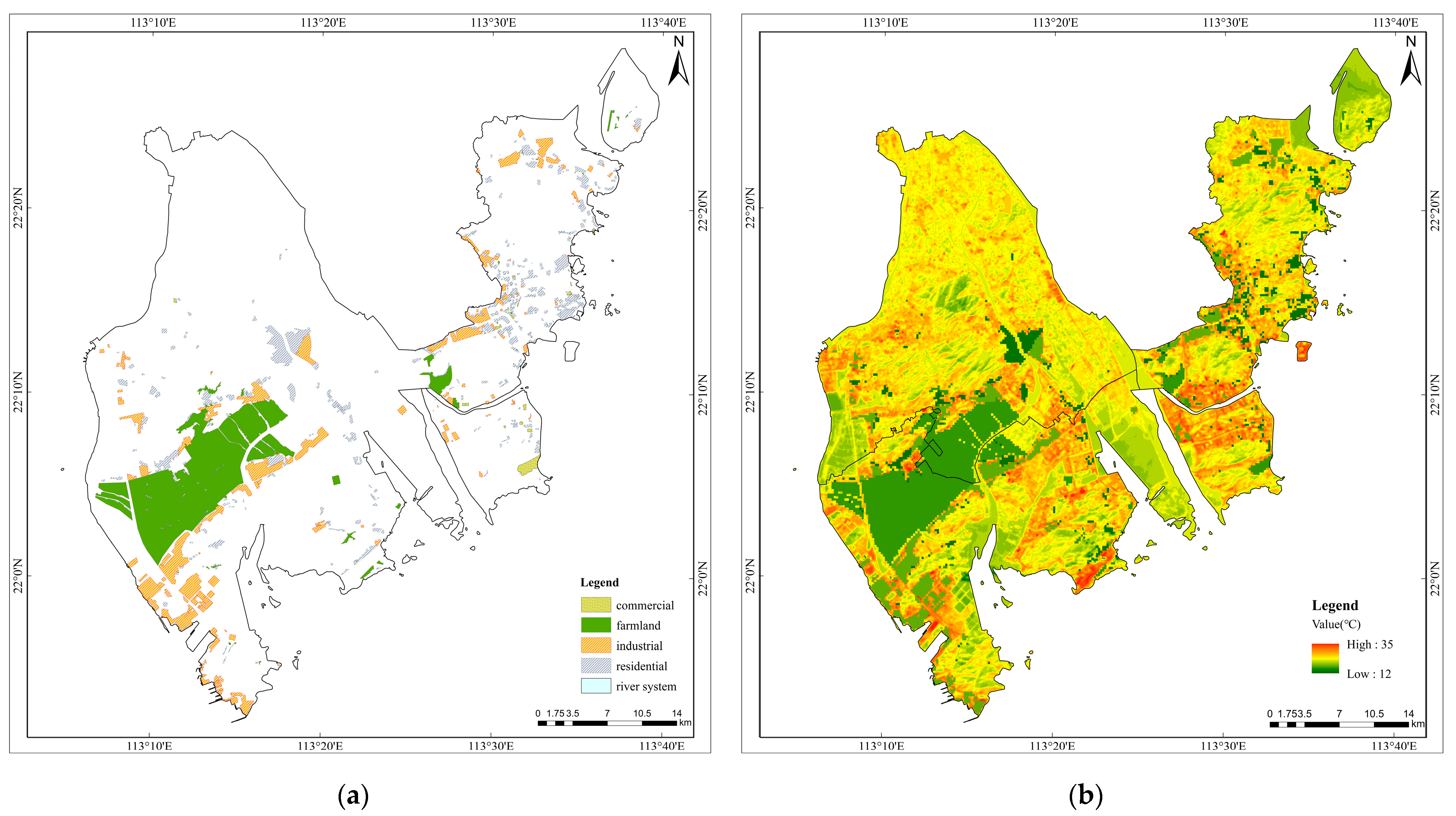

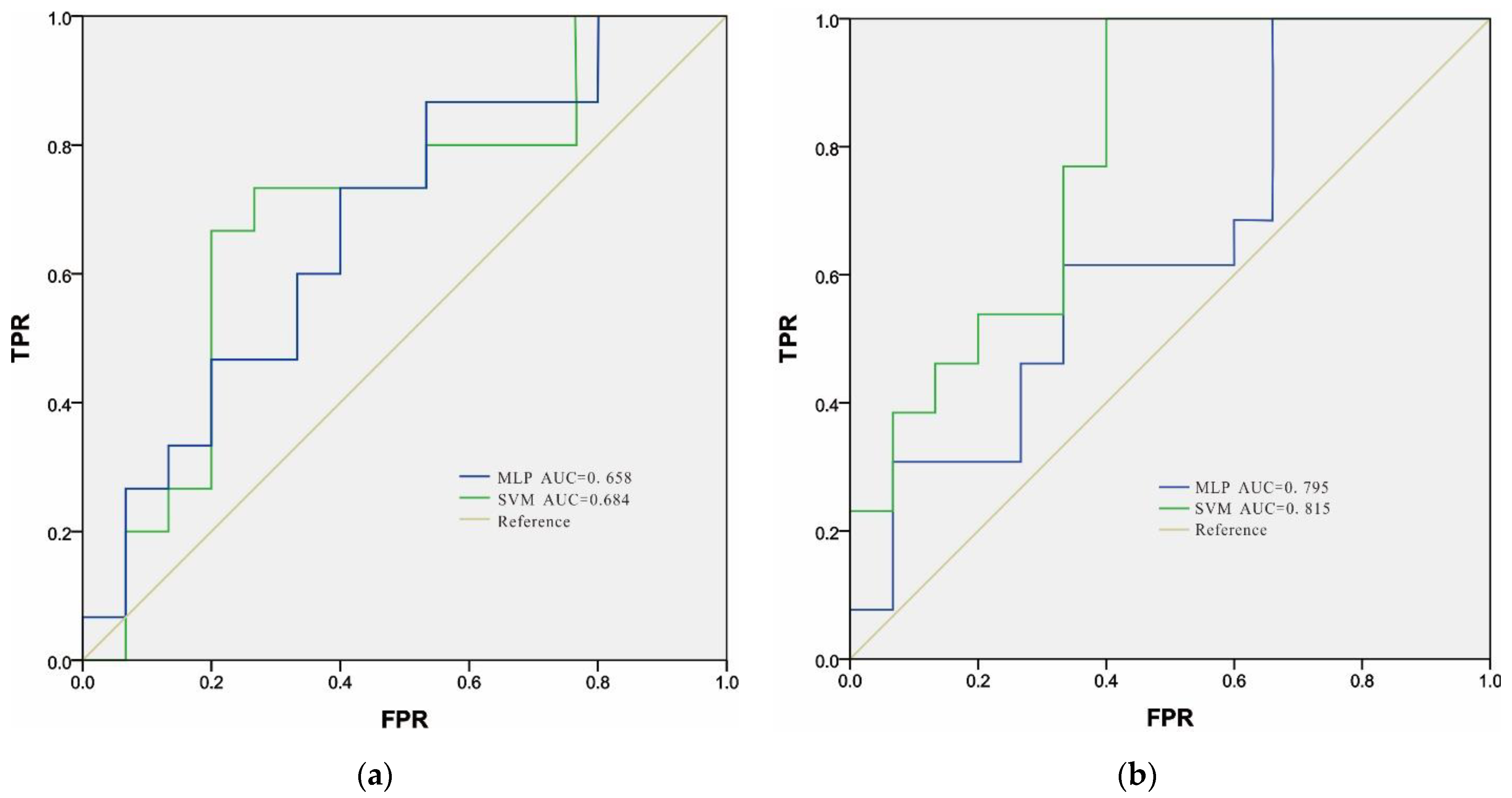
| Class | Area (km2) | Image Feature |
|---|---|---|
| Farmland | 121.73 |  |
| Industrial | 66.84 |  |
| Commercial | 3.62 | 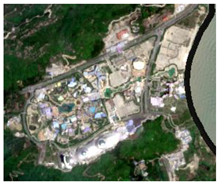 |
| Residential | 50.32 | 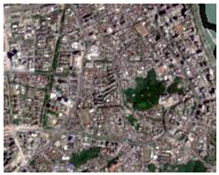 |
| Class | Based on Original LST | Based on Reclassified LST | ||
|---|---|---|---|---|
| SVM | MLP | SVM | MLP | |
| Very low | 16.99% | 11.63% | 16.71% | 16.56% |
| Low | 23.80% | 19.01% | 20.11% | 22.65% |
| Moderate | 26.90% | 46.27% | 20.34% | 28.67% |
| High | 22.77% | 16.32% | 24.16% | 18.70% |
| Very High | 9.54% | 6.76% | 18.68% | 13.42% |
Disclaimer/Publisher’s Note: The statements, opinions and data contained in all publications are solely those of the individual author(s) and contributor(s) and not of MDPI and/or the editor(s). MDPI and/or the editor(s) disclaim responsibility for any injury to people or property resulting from any ideas, methods, instructions or products referred to in the content. |
© 2024 by the authors. Licensee MDPI, Basel, Switzerland. This article is an open access article distributed under the terms and conditions of the Creative Commons Attribution (CC BY) license (https://creativecommons.org/licenses/by/4.0/).
Share and Cite
Bian, Y.; Ni, Y.; Guo, Y.; Wen, J.; Chen, J.; Chen, L.; Yang, Y. Urban Geothermal Resource Potential Mapping Using Data-Driven Models—A Case Study of Zhuhai City. Sustainability 2024, 16, 7501. https://doi.org/10.3390/su16177501
Bian Y, Ni Y, Guo Y, Wen J, Chen J, Chen L, Yang Y. Urban Geothermal Resource Potential Mapping Using Data-Driven Models—A Case Study of Zhuhai City. Sustainability. 2024; 16(17):7501. https://doi.org/10.3390/su16177501
Chicago/Turabian StyleBian, Yu, Yong Ni, Ya Guo, Jing Wen, Jie Chen, Ling Chen, and Yongpeng Yang. 2024. "Urban Geothermal Resource Potential Mapping Using Data-Driven Models—A Case Study of Zhuhai City" Sustainability 16, no. 17: 7501. https://doi.org/10.3390/su16177501





